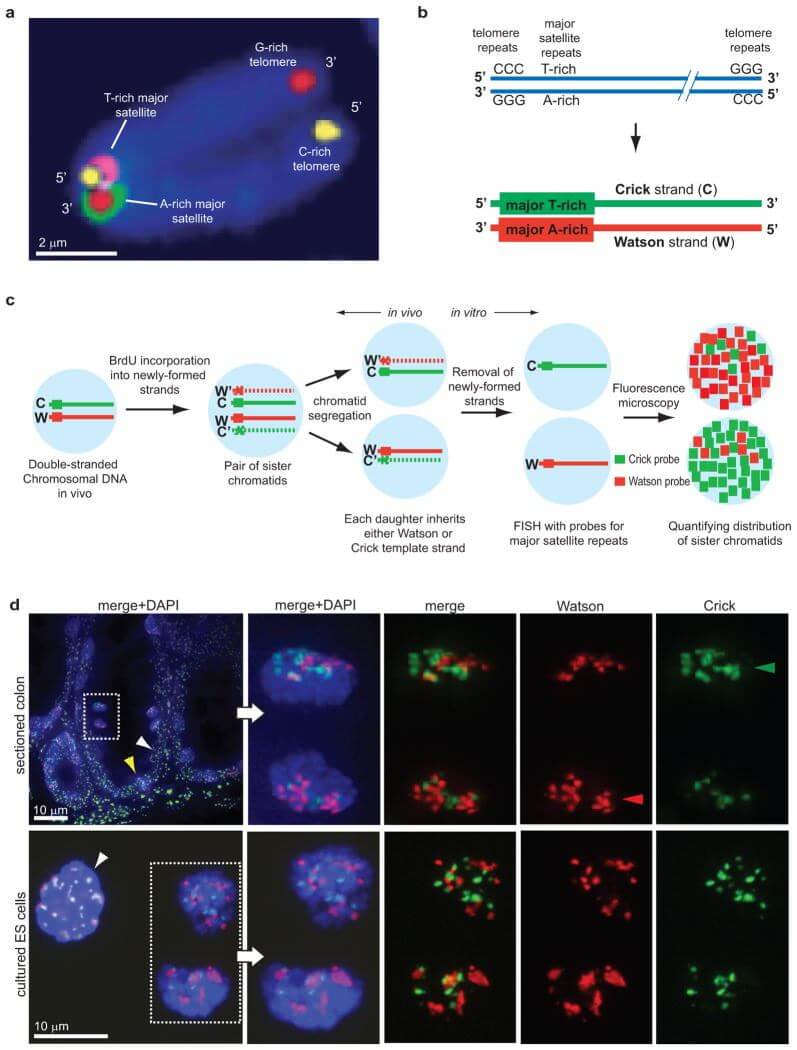Chromosome Orientation FISH (CO-FISH) Service
Chromosome Orientation FISH (CO-FISH)
Chromosome orientation FISH (CO-FISH) is a technique that can be used to extend the information obtained from standard FISH to include the relative orientation of two or more DNA sequences within a chromosome. CO-FISH requires culturing cells in the presence of bromodeoxyuridine (BrdU) and/or bromodeoxycytidine (BrdC) for a single round of replication (a single S phase) to integrate BrdU into the newly synthesized daughter chain (unifilar substitution). The daughter strands are specifically removed by nuclease digestion, and the remaining single-stranded chromosomal DNA is an ideal target for single-stranded probe hybridization. Through this technique, the absolute 5' to 3' direction of the DNA sequence relative to the short arm to the long arm axis of the chromosome can be determined, so it was originally called "COD-FISH" (Chromosome Orientation and Direction FISH). CO-FISH and related technologies have been used for many purposes, but this kind of chain-specific FISH hybridization may have more applications to be discovered.
 Fig 1. Uniform orientation of mouse chromosomes as shown by four-colour CO-FISH. (Falconer E, et al. 2010)
Fig 1. Uniform orientation of mouse chromosomes as shown by four-colour CO-FISH. (Falconer E, et al. 2010)
CO-FISH Services
Our CO-FISH provides a series of telomere region-specific probe sets, centromeric region-specific probe sets, customized region-specific probe sets and composite probe sets to complete customer analysis projects. The service process includes experimental protocol customization, sample preparation, probe preparation, antigen retrieval and Nuclease processing, removal of newly formed DNA strands, FISH hybridization, image and data services. You can send the prepared tissue sample slices or cells to our laboratory, or you can send us the tissue sample and unprocessed cells, and we will complete the relevant steps. Our FISH platform has many years of relevant service experience and can provide customers with high-quality data. You can participate in the supervision of project progress online. Ensure that customers can get quality-assured analysis results on time. The samples provided by CO-FISH require BrdU processing, and the tissues and cells are harvested after BrdU processing. After that, we provide optional fixation and other operations to finally form sample slices or cell samples for subsequent detection.
 Fig 2. Advanced CO-FISH service process.
Fig 2. Advanced CO-FISH service process.
Application of CO-FISH Services
CO-FISH extends the information obtained from standard FISH. Using appropriate reference probes and combination probe sets, CO-FISH can also determine the absolute 5'to 3'direction of the DNA sequence relative to the axis of the short arm to the long arm of the chromosome. CO-FISH has been used to detect chromosomal inversions and various central inversions related to isochromosome formation, and to confirm the origin of lateral asymmetry.
- CO-FISH technology is used to further analyze the satellite DNA (satDNA) around the major and minor centromeres of the telomere and Robertson (Rb) translocation chromosomes.
- The chain-specific hybridization of CO-FISH can be used to determine the absolute direction of various repetitive sequences at any position along the DNA helix in the chromatids.
- CO-FISH can limit the hybridization of single-stranded probes to one of the two sister chromatids (for any unique locus), which means it can also be used for inversion detection.
- CO-FISH studies have found that there are chain-specific differences in the post-replication processing of mammalian telomeres. For example, fusions preferentially involve telomeres produced by DNA synthesis from the leader strand.
- CO-FISH helps to discover and prove previously unrecognized pathways for the formation of exchange-type aberrations in cells with telomere dysfunction, such as determining telomere-DSB fusion.
- CO-FISH technology can be used to analyze telomere sister chromatid exchange (T-SCE).
- CO-FISH technology can be used to analyze the replication time during the S phase of cell replication and replicative detargeting FISH ( ReDFISH).
Creative Bioarray provides a variety of region-specific probes for CO-FISH analysis and testing to help our customers save costs. You will benefit from our advanced technology platform and experienced laboratory team. We will work with you to find the best solution to meet your needs through personalized customized services. If you are interested in our CO-FISH testing service, please contact us for cooperation. We look forward to cooperating with you in the near future.
References
- Bailey S M, Goodwin E H, Cornforth M N. Strand-specific fluorescence in situ hybridization: the CO-FISH family[J]. Cytogenetic and genome research, 2004, 107(1-2): 14-17.
- Falconer E, Chavez E, Henderson A, et al. Chromosome orientation fluorescence in situ hybridization to study sister chromatid segregation in vivo[J]. nature protocols, 2010, 5(7): 1362-1377.
- Williams E S, Bailey S M. Chromosome orientation fluorescence in situ hybridization (CO-FISH)[J]. Cold Spring Harbor Protocols, 2009, 2009(8): pdb. prot5269.
All products and services on this website are only suitable for non-medical purposes.


 Fig 1. Uniform orientation of mouse chromosomes as shown by four-colour CO-FISH. (Falconer E, et al. 2010)
Fig 1. Uniform orientation of mouse chromosomes as shown by four-colour CO-FISH. (Falconer E, et al. 2010) Fig 2. Advanced CO-FISH service process.
Fig 2. Advanced CO-FISH service process.


